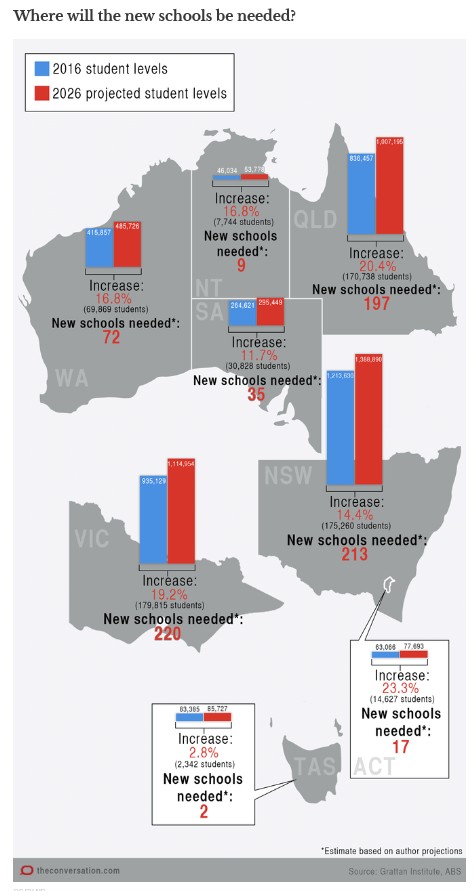The NSW government is suddenly sporting the bogan bumper sticker “fuck off, we’re full”:
Children as young as five are being rejected by NSW public schools because their parents are temporary visa holders while schools across Sydney overflow with enrolments.
Five-year-old Frederico Jemma was born in Sydney to Italian parents who have lived in NSW for seven years on temporary visas. Both have paid taxes and are happy to stump up the $5000 it costs to send an international student to a local public school.
But in September they were told there was no room for Frederico at Kensington Public.
Enrolments have skyrocketed by between three and five times the NSW average over the past four years across the Waverley, Canada Bay, Sydney and Ryde local government areas, according to a Fairfax Media analysis of Department of Education figures. At Kensington Public they have surged 14 per cent in that time alone.
Frederico was rejected because he was the son of migrants who had been unable to stay in the one job for the more than two years necessary to gain sponsorship and permanent residency.
As the son of temporary visa holders, Frederico is ineligible for citizenship until he turns 10.
The irony of it all! It’s not just Sydney. Melbourne’s public schools are now suffering from chronic over-crowding as they struggle to keep pace with the rampant population growth.
In June, it was reported that some Melbourne school students were being forced to work on cushions on the floor and play in neighbouring parks because there simply is not the space to accommodate them. The situation was most acute in Melbourne’s inner-city areas, where schools are simply being overrun by the student influx.
And back in February, Peter Goss, School Education Program Director at the Grattan Institute, penned an excellent article in The Conversation assessing the upcoming shortage of schools across Australia’s capital cities as the nation’s population balloons. This article estimated that the number of school students would balloon by 650,000 (17%) by 2026, which would require the building of an additional 400 to 750 new schools (up from 9,400 currently). Victoria (mostly Melbourne) alone would need an additional 220 schools to cope with an additional 19% of students over the next decade (see below graphic).

Melbourne’s inner city would be worst affected, according to Grattan:
In the inner city, the big issue is the cost and scarcity of land… Governments have been much worse at planning for the booming number of inner-city children…
Worse is to come, especially in Melbourne. Melbourne’s five most central local government areas will each see a 30% to 60% increase in student numbers over the next decade… Inner-city parents in urban redevelopment zones are the most likely to have problems getting their children into a government school.
The Age reported that the Victorian Government has announced that it will build four new inner-city schools in a belated attempt to alleviate some of the pressures of rampant student growth:
There’s an anxiety that grips Docklands families as their children grow up.
They have two options – move house when their child reaches prep, or a long, annoying commute in peak hour traffic to a school outside their neighbourhood…
The Andrews government… announced on Tuesday that “over the next few years” a primary school in the Docklands, a primary and secondary school at Fishermans Bend and a new primary school in North Melbourne would be built to accommodate the student boom.
The government will also purchase a new site to expand the popular Albert Park College.
It follows a relentless campaign from Docklands parents, who have been crying out for a new school for 15 years. Successive governments have promised these families a school, and three studies into the sought-after education facility have been commissioned.
Frustrated parents at North Melbourne Primary – who claim free range chickens have better rights than their children in cramped classrooms – have also been fighting for new inner-city schools to ease the overcrowding. Students have complained of sore backs from sitting on the classroom floor, because there are not enough seats…
Education Minister James Merlino said… “Enrolment growth right across Melbourne and Victoria is just extraordinary… We are seeing that pressure right here in the inner-city, in the growth corridors of Melbourne and in our growing regional cities”…
Mr Merlino said the new schools would create 5000 new places for students.
Too little too late, I’m afraid. Creating 5,000 new places for students will barely hit the sides given nearly 180,000 places will be needed statewide over the coming decade, according to Grattan.
All of this, yet again, highlights Australia’s dysfunctional population ponzi.
The Federal Government massively ramped-up immigration from 2003 which, when combined with the mini baby boom encouraged by the baby bonus, is leading to surging demand for schooling.
However, the states have been unable to accommodate this growth – due in part to incompetence, but also through lack of funds courtesy of Australia’s famous vertical fiscal imbalance, whereby the federal government collects most of the revenue.
This dysfunction is arguably most apparent across inner city areas. The states have been successful in forcing urban consolidation and infill development, as evidenced by the proliferation of apartment development across our major cities. However, they have been totally unsuccessful in providing the necessary infrastructure to accommodate this growth, be it schools or transport infrastructure.
None of this matters when the object of policy is simply to keep property prices elevated. Gormless specufestors are inhibited by an education.

